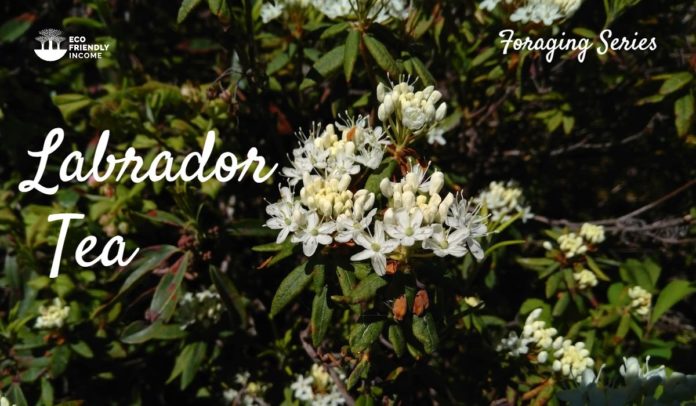It’s one of those traditional wild herbs of North America. It’s pretty common once you’re in the boreal forest, and luckily, identifying Labrador tea plants (Rhododendron groenlandicum) is pretty easy. It has a lemony aroma that’s easy to recognize and it makes a healthy, fragrant tea.
You can also extract its essential oil to make perfume, soap, or even candles. Mmmm.
As a tree planter working in the boreal forest, I’ve seen labrador tea countless times, it’s very common. In some places that I plant, it’s almost like a weed! But once you leave the boreal forest, it’s almost non-existent.
Labrador tea is one of the first herbs settlers learned to use when they arrived in North America. Native American shamans knew of this medicinal plant for generations already and shared their knowledge with the Europeans.
Despite this plant being so common in my area, doesn’t mean I shouldn’t be thoughtful when harvesting it. When I forage for this herb, I really try to pick sustainably, and I think everyone should.
If you go out picking all the labrador tea plants near you, they simply won’t come back.
Here’s what you can expect to learn in this article:
- Labrador Tea Picking Season
- How to Identify Labrador Tea
- Where You Can Find it
- How to Harvest it Sustainably
- How to Propagate Labrador Tea
- How to Store it
Let’s get started!
Labrador Tea Picking Season
Labrador Tea is an evergreen plant, which means it won’t lose its leaves during winter. This means they can be picked at almost any time of the year.
There are two general consensuses as to when you want to pick the leaves.
- When the underleaf hairs are white (new growths)
- When the underleaf hairs are copper-colored (previous year’s growth)
Personally, I’ve tried both, and I find the new growths to have a smoother taste, that’s what I recommend to look for when you’re foraging.
It’s all down to whether you’re looking for a strong, robust flavor (the copper-colored underleaf) or a smoother, milder flavor (the white underleaf).
There’s also another factor I’ve noticed, the taste of the tea often changes from place to place. Some more nutrient-rich areas produce stronger flavored plants and other areas produce smoother varieties.
How to Identify Labrador Tea Plants (Rhododendron groenlandicum)
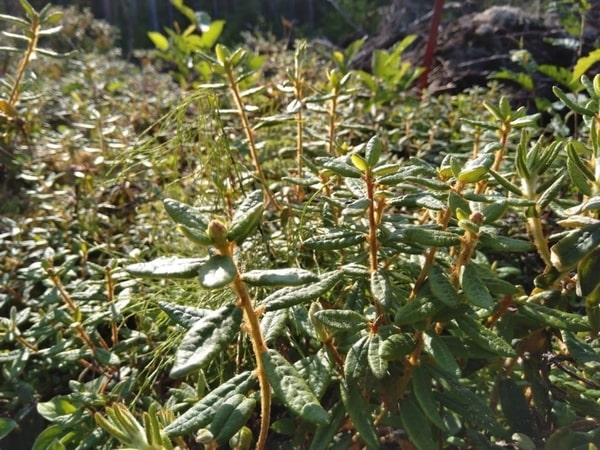
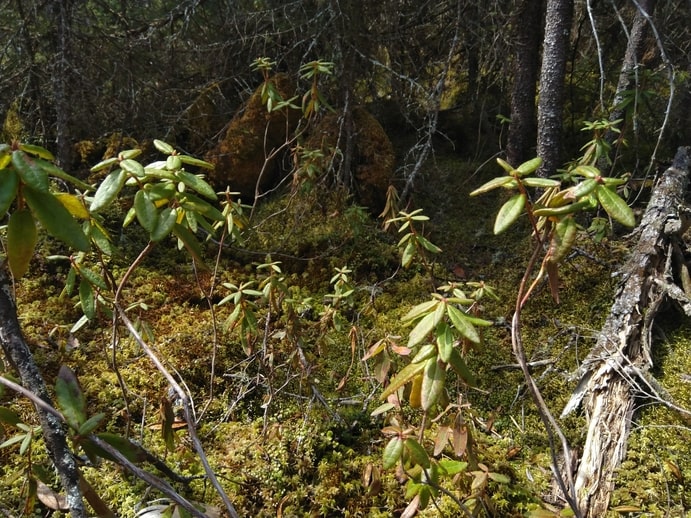
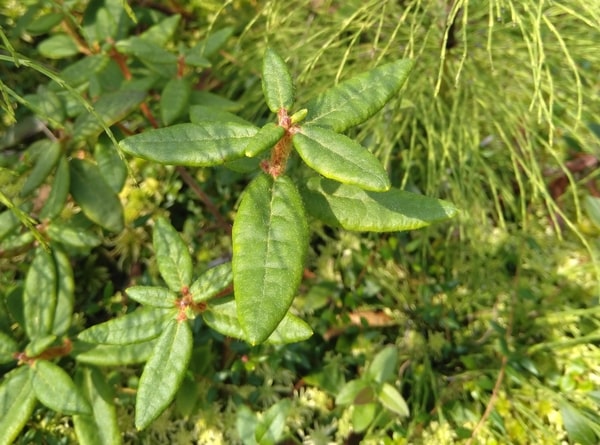
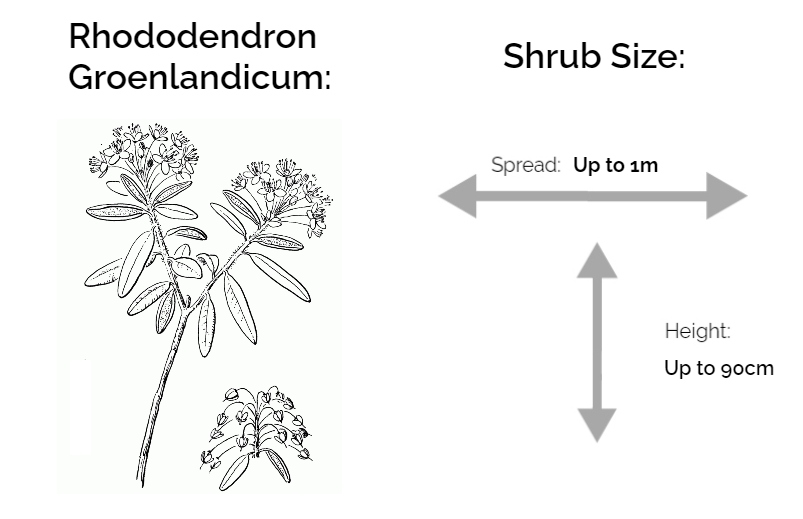
Labrador tea has long elliptical-shaped leaves, with a distinctive white velvet underside. They grow in an alternate arrangement, have curled-under, entire margins.
As the leaves get older, the white color turns into a rusty brown color and the plant stems become hard and woody.
They are also some of the first plants to flower in the boreal forest. You can see them bloom gorgeous white flowers from mid-May to early June.
Another way to identify Labrador tea plants is to recognize them by their aroma, which smells similarly to lemon.
New stems also have small bristle-like hairs growing on them.
Labrador Tea Plant Look-alikes
There’s a plant that looks very similar to labrador tea to the untrained eye. It’s important not to confuse them because the latter is mildly toxic. You wouldn’t want to ingest it unless you’re looking for tummy aches.
The leaves look similar, but there are a few details to look at to tell them apart.
Kalmia (Kalmia angustifolia)
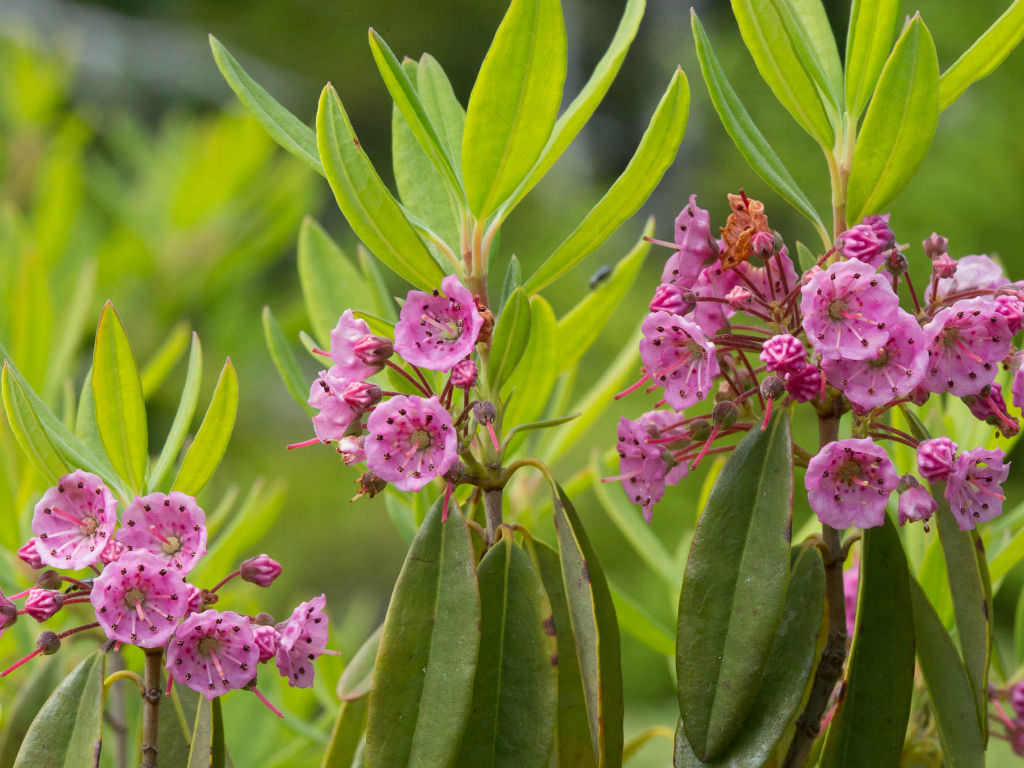
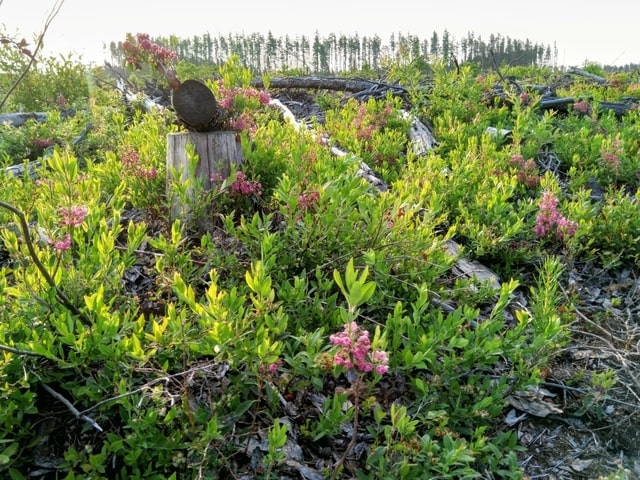
How to differentiate Kalmia from Labrador Tea
- Kalmia leaf underside does not have velvet-like hairs, while Labrador tea does.
- Kalmia flowers are pink, while Labrador tea flowers are white.
- Labrador tea leaf edges curl inward, while kalmia leaf edges are relatively straight.
Looking at these three traits, it’s easy to differentiate the two. Really the easiest and most fool-proof way to differentiate them is by looking at the leaf underside.
Where You Can Find Labrador Tea Plants
Labrador tea grows in large colonies around peat bogs, swamps, mossy forests.
It also likes to grow in the undergrowth of humid coniferous forests.
It’s found in all of Canada’s boreal forests and grows as south as Pennsylvania.
My favorite spot for picking Labrador tea is in my home region of Abitibi, Qc. The area is a large boreal forest covered with peatlands, lakes, and sphagnum bogs, their preferred habitat.
I’ve seen Labrador tea (Rhododendron Groenlandicum) grow near the following plants:
- Pitcher Plants (Sarracenic purpurea)
- Bluebead (Clintonia Borealis)
- Bog Rosemary (Andromeda polifolia)
- Creeping snowberry (Gaultheria hispidula)
- White Pine (Pinus strobus) & Jack Pine (Pinus banksiana)
- Kalmia (Kalmia Angustifolia)
When you see any of these, there’s a good chance labrador tea is somewhere close.
How to Harvest Labrador Tea Plants Sustainably
Since this plant doesn’t grow very fast, you want to be very thoughtful of each shrub when you pick.
My personal method for picking Labrador tea sustainably:
- Pick a plant that has enough neighbors (leave the single plants alone)
- Use a sickle or pinch with your fingers the 5-6 bottom leaves from a plant
- Move on to the next plant
It’s simple, taking the bottom leaves will minimally harm the plant, and it’ll keep growing.
Preferably, take the copper underside leaves if you can, those are the old growths. This year’s growths have a white underside but can only be harvested from the top.
If you want to harvest new year growths, take the caps off from a few plants per colony and move over to a new colony.
How to Propagate Labrador Tea Plants (Rhododendron groenlandicum)

Hardiness Zone: 2-6

Soil Type: Well-drained, moist to wet, acidic, nutrient-poor organics soils.

Water: Normal. Fair Drought tolerance.

Exposure: Full Sun to Partial Shade
Labrador Tea (Rhododendron groenlandicum) is an evergreen shrub hardy up to zone 2. A Labrador tea shrub should be planted in well-drained, moist to wet, acidic, nutrient-poor organics soils. You should water it weekly to make sure it retains moisture, especially when flowering.
Commercial Value
Propagating Labrador tea has some merit commercially. The leaves have a delicious flavor and hold medicinal properties which make it a popular tea.
Additionally, labrador tea essential oil has many uses. From making perfumes to soaps, lip balm, gum, and candles.
Growing and propagating labrador tea is possible if you have the right environment.
The Best Way to Propagate Labrador Tea Plants:
Division
Labrador tea can be propagated by root crown division.
Here’s how to do it:
- Find a wild labrador tea patch and identify the largest plant.
- Try to pull the plant out, if there’s resistance, look at where the roots go and try to dig them out.
- Once you have the plant out, you can split the root crown by hand or with a sharp knife from top to bottom.
- Make sure both sides have enough roots before you divide.
- Now take a good look at your divided plants, remove any dead or diseased foliage.
- Repot the two individually and water thoroughly until they are established.
You want to divide labrador tea plants only during spring or early summer. This way the divided plants have time to establish themselves before next winter.
Since blooming takes energy, you should divide labrador tea plants only after they bloomed in May-June.
Layering
Another good way to propagate labrador tea is to transplant a wild plant and plant it deeper than you normally would.
When you do that, its branches will be closer to the ground and have more chances of rooting naturally.
To force layering, you can select the longest branches and bury them underground yourself.
Hold them down with a landscaping pin and eventually, they will root. Afterward, you can separate the branch from the main plant and transplant it.
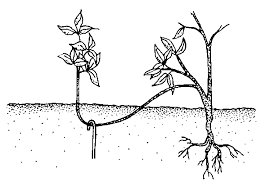
Hardwood Cuttings
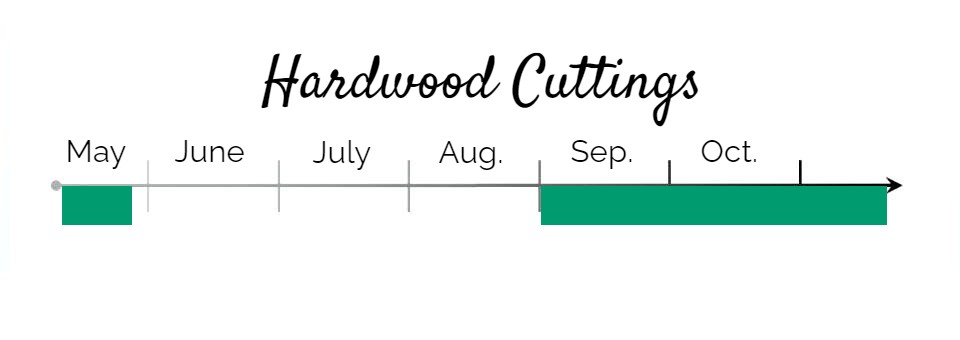
First, when you take hardwood cuttings for labrador tea, you wanna cut them during fall or early spring.
- First, take some hardwood cuttings off the main stem, at about 6-8 inches ea.
- Make sure the width of the cutting is not too thin, then cut or tear them with a heel*.
- Remove the leaves from about half of the cutting.
- Wound the base of the cuttings with a vertial line on opposite sides, about 1 inch long.
- Dip in rooting hormones and then plant into your sandy propagation beds.
- Keep watering the rooting medium, sand shouldn’t be too wet but it should stay moist.
- Roots are slow and can take longer than 8 weeks to grow.
- For winter, no need to cover, the snow isolates very well.
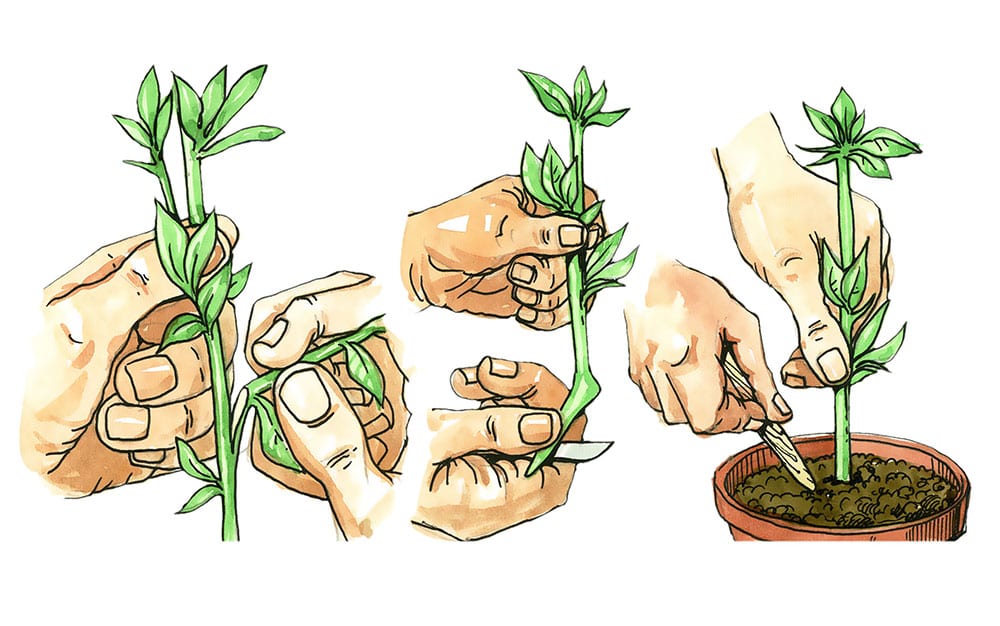
Recommended rooting medium: Sand with perlite mix.
Labrador tea hardwood cuttings are slow to root and generally take 6-8 weeks.
How to Store Freshly Picked Labrador Tea Leaves
To retain the top flavor and fragrance, labrador tea leaves need to be dried and stored properly.
First, you want to air dry them. What I do is use a mesh bag when I collect leaves, then when I’m done I hang up the mesh bag.
You don’t want to hang the mesh bag directly in the sun, or it risks breaking apart the inner components and oils of the leaves.
Let them air dry for a week.
Finally, place them in a sealed mason jar, stored away in a cool dark place.
When you feel like tea, just add 4-5 leaves to a cup and let them steep for 5 mins in hot water. You’ll get to smell and taste the delightful aroma again!

